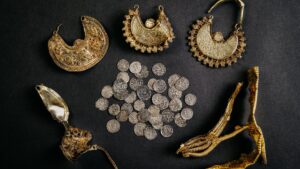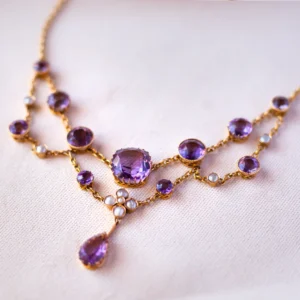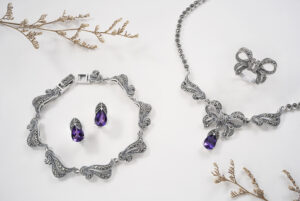Marcasite jewelry holds a unique place in European history, prized for its metallic sheen, elegant craftsmanship, and affordability compared to precious gems. From ancient roots to Art Deco splendor, the journey of marcasite jewelry in Europe is both rich and fascinating. Marcasite jewelry

Early Uses in Ancient Europe
Marcasite often confused with pyrite was used by ancient Greeks and Celts for decorative and spiritual purposes. Archaeological findings show marcasite set into bronze or silver to form brooches, pendants, and religious talismans.
The Renaissance and Symbolic Jewelry
During the Renaissance period, marcasite became popular among the European elite. Craftsmen set tiny faceted pieces into silver to create shimmering effects in rings, earrings, and lockets. Marcasite was often used in mourning jewelry, symbolizing sorrow and remembrance.
Victorian Influence and Sentiment
Queen Victoria’s love of dark, romantic styles helped marcasite flourish in the 19th century. After the death of Prince Albert, mourning jewelry became widespread. Marcasite served as a stylish, affordable substitute for diamonds, making it a staple in Victorian fashion.
Art Nouveau & Art Deco Movements
In the early 20th century, marcasite jewelry evolved dramatically:
- Art Nouveau (1890–1910): Designers like René Lalique featured marcasite in flowing, nature-inspired forms. Butterfly brooches, floral pendants, and whimsical earrings were common.
- Art Deco (1920s–1930s): The era of bold geometry and glamour brought marcasite to new heights. It was frequently paired with onyx or enamel in sleek, symmetrical designs.
Post-War Revival
Following World War II, marcasite jewelry experienced a resurgence. European manufacturers focused on affordable, elegant pieces for women re-entering the workforce. Sterling silver settings with marcasite accents became everyday staples.
Modern-Day Popularity
Today, marcasite jewelry continues to be a beloved choice in Europe for both vintage collectors and modern fashion lovers. Countries like Germany, France, and the UK maintain strong production and export traditions in sterling silver marcasite designs.
Why Marcasite Jewelry Endures in Europe
- Timeless appeal: Its antique look suits both retro and contemporary tastes.
- Affordable elegance: It offers sparkle and texture without high costs.
- Craftsmanship: European artisans are known for fine, detailed marcasite setting work.
From ancient artifacts to chic vintage pieces, marcasite jewelry in Europe tells a story of enduring style, emotion, and craftsmanship. Whether as a statement ring or a subtle brooch, marcasite remains a timeless treasure rooted deeply in European culture.







